EXPERT INSIGHT
3 Reasons Why Your Multi-Laser 3D Printer Is Inefficient without the Right Load Balancer Software
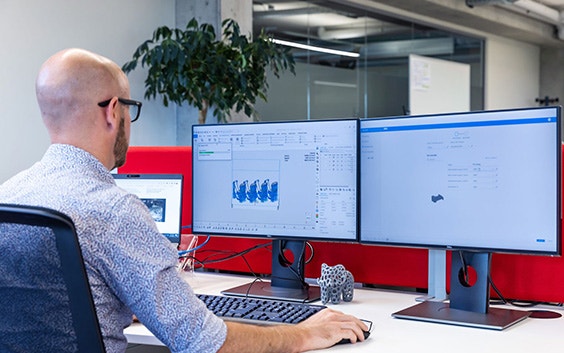
Most 3D printers on the market were originally designed for rapid prototyping. However, as the industry matured, serial production use cases became more feasible, and organizations began maximizing the ROI of their AM investment. From designing a high-performant monolithic part, automating the shop floor, and developing new materials to optimizing each machine parameter to increase speed, quality, and performance.
The rise of multi-laser machines has rapidly increased since the first twin laser system was introduced in 2015 by SLM Solutions.1 Since then, a growing number of original equipment manufacturers (OEMs), machine builders, and enterprises have begun customizing their own 3D printers for production, adding more lasers with the goal of increasing productivity.
When it comes to laser powder bed fusion (LPBF) and direct metal laser sintering (DMLS), most users believe that more lasers should automatically improve speed and productivity. Unfortunately, that is not always the case. The challenge that continues to persist is how to effectively distribute the workload among lasers to enhance productivity while maintaining high-quality output. The solution is finding the right build processor software to optimize every laser’s capability.
Key discoveries from our production floor
“Based on my experience, I’d argue that many machines aren’t being used efficiently. People assume that adding more lasers should automatically increase the speed and productivity of their production, R&D, or other projects. This isn’t the case.” states Johan Troukens, Market Solution Architect at Materialise Software. “You need technology that maximizes laser utilization in an efficient way. Without it, these systems are inefficient.”
For example, a 3D printer with four lasers may only be using the effectiveness of 3.2 lasers during production. That’s why having more lasers in your 3D printer does not equate to increasing your productivity.
To overcome the challenge of maximizing laser utilization, three main factors must be considered:
- Applying effective laser load distribution
- Reducing your 3D printing time
- Enabling satisfactory print quality output
Inefficient execution of build processing strategies for multi-laser machines will critically reduce a machine’s overall equipment effectiveness (OEE). This raises the question: how can you optimize the output of your six-figure to multi-million-dollar 3D printing asset?
Load Balancer unlocks the full capabilities of multi-laser metal 3D printers. Part of the Build Processor Software Development Kit (BP SDK), Load Balancer’s configurable algorithm allows users to adjust the parameters for each laser — a technique that’s not readily available in other comparable 3D printing load balancer software.
BP SDK enables users to employ an out-of-the-box solution or develop their own Build Processors for their specific production requirements. Such flexibility is invaluable for R&D, process engineers, or anyone interested in tinkering with their multi-laser 3D printers to boost efficiency.
“Load Balancer provides a productivity increase of approximately 25% over conventional multi-laser systems,” says Michele Pavan, Research Engineering Manager at Materialise Software. “That means less time and resources wasted on dealing with issues such as overheating, gas obscuring beams, and spatters landing on unscanned areas of the build platform.”
Overcoming the challenges of laser distribution
“The 3D printing industry is experiencing a shift towards sustainable and efficient practices to reduce carbon emissions and energy consumption. Companies need to improve their bottom line while producing high-performing parts to carve out their competitive advantage,” states Brecht Pellens, Product Manager at Materialise Software. “A significant part of this evolution lies in maximizing the value derived from each operation while meeting quality standards.”
Here are a few examples of how you can overcome certain challenges associated with laser load distribution to maximize utilization and harness the full potential of your multi-laser machines with the Load Balancer.
1 — Achieve optimal load distribution by controlling each laser
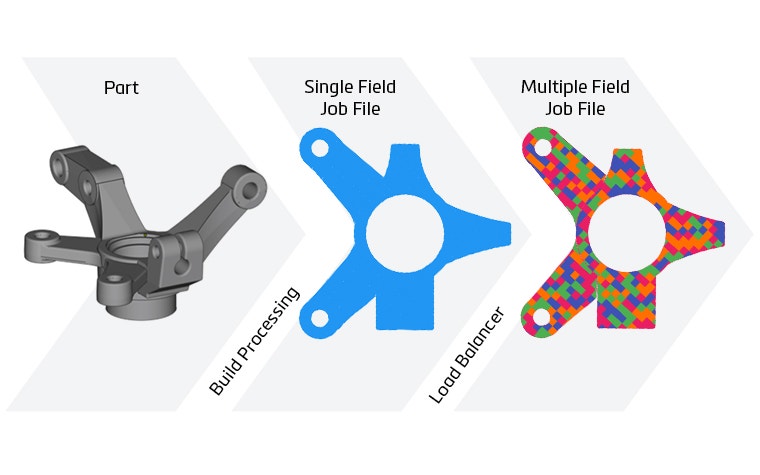

Load Balancer’s algorithm streamlines the task of balancing the load per laser, while accounting for gas flow and fog zones to prevent interference between lasers and ensure uniform energy distribution.
It will distribute the toolpaths of the job file by calculating the optimal load for each laser, taking all process, and user constraints, into account. The output is a job file with the most optimal distribution for each toolpath among all the lasers, resulting in a significant productivity increase.
2 – Configure fog zones to improve quality by optimizing gas flow and avoid downwind processing
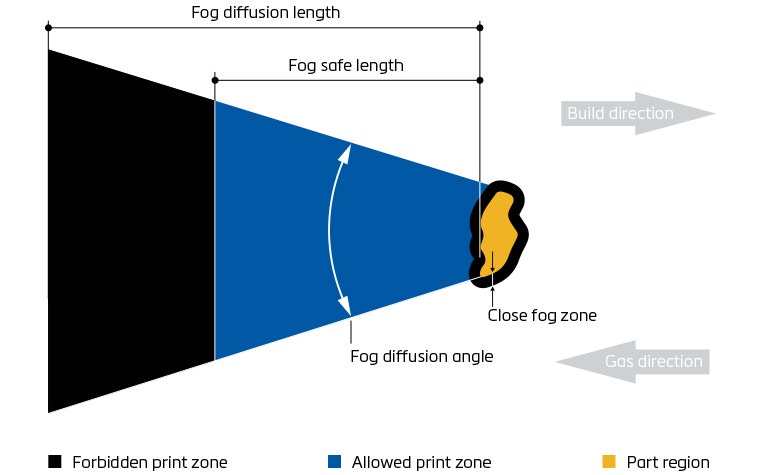

Managing quality is complex, especially with multi-laser systems. Lasers normally generate fog and gas plumes that travel toward the set gas flow. Plumes in these fog zones can obscure lasers working near each other, reducing their efficiency.
In addition, when lasers operate in confined spaces, they’ll emit excess energy, which may adversely impact the meltpool and the part’s quality. By calculating the fog zone per laser, the algorithm can optimize complex sorting, such as deciding which vector blocks to scan first while adhering to the rules, with the goal of avoiding downwind and fog zone processing. This helps maintain the quality of the laser beam, preventing interference between them, while ensuring equal energy distribution.
Loose powder on the powder bed can further impact the quality of the print if not addressed appropriately. To avoid spatters, gas obscuring beams, and overheating, Load Balancer can model the gas flow, ensuring the laser never scans into the gas flow of another laser beam.
3 — Fuse productivity and quality to enable optimal print quality output
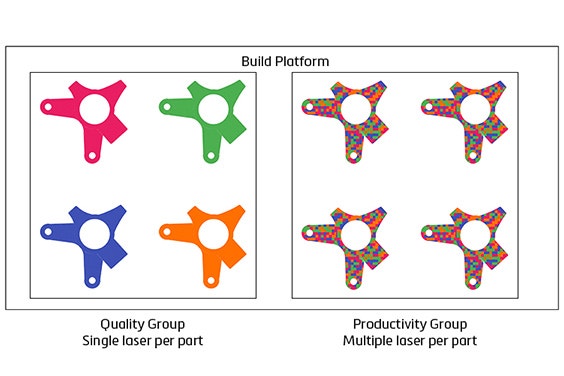
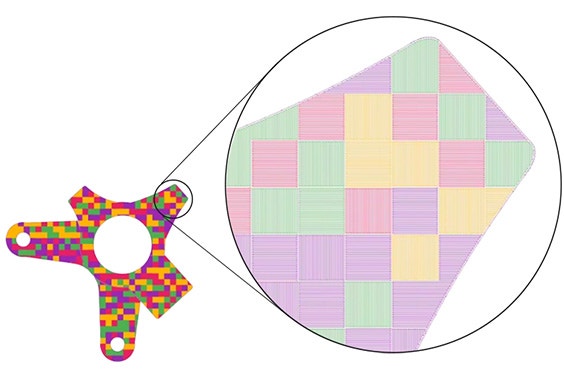
“The attraction of Load Balancer is that it ensures every laser works optimally without them intersecting in an adverse way — resulting in faster processing times while maintaining build quality,” says Michele.
The proximity of multiple lasers can introduce excessive energy, decreasing the overall quality of the print because it can result in porosity and keyhole defects in the part. With Load Balancer, precise and uniform energy deposition is necessary for increasing control of the laser beams to achieve high-quality outcomes.
Plus, Load Balancer can introduce vector block splitting, a next layer of granularity upon the user’s input. Typically, a layer consists of a minimum of one vector block. However, the algorithm can split larger vector blocks into smaller ones, which increases the granularity of the layer, resulting in an improved load distribution over all lasers. The benefit of this technique is that the overall distribution can be finetuned even further to allow for improved efficiency of your 3D printer.
One reason why production time may be unoptimized is due to the number of jumps a laser may make when 3D printing a part. With bands, the goal is to limit the area of effect for each laser — decreasing the number of jumps. This contributes to improving the overall productivity and reduces the close interaction between lasers working on the same part.
Finally, the hybrid mode option in Load Balancer, allows users to choose whether a part should be scanned by an individual laser or optimized by the algorithm to distribute the vectors between the different lasers. This leads to a more optimal load distribution.
“It only takes a few clicks to set up your parameters. But you can also customize and tweak each one in minute detail for as long as you like,” says Brecht.
Multi-laser 3D printing that’s optimized for your LPBF production
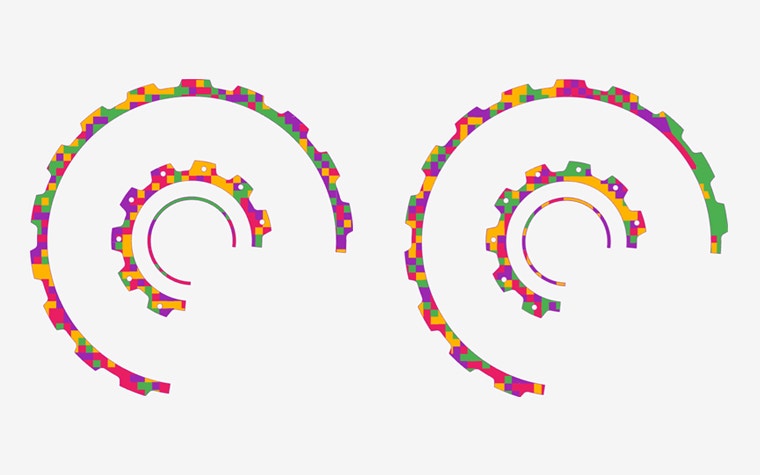

Optimizing multi-laser 3D printers could be an excellent way to increase productivity in your metal 3D printing production while reducing costs and lead times — if the scan path strategy was designed the right way. However, users and even manufacturers often underutilize these capital-intensive pieces of equipment because they’ve not invested in the right software.
Load Balancer is the tool to solve your multi-laser printer dilemma. Utilizing this module as part of our BP SDK or your own Build Processor opens new avenues for innovation, reduces your development costs, and accelerates your time-to-market. In addition, Load Balancer is natively accessible on our CO-AM Software Platform via Machine Manager.
“Load Balancer’s quick and easy setup is perfect for everyone: whether you’re a process engineer wanting to fine-tune every aspect of your application or you’re a user not as familiar with the technology and preferring a more streamlined integrated approach. This type of AM tool is a game changer: it harnesses the full power of your manufacturing resources to transform your operations into tangible results,” says Johan.
Share on:
You might also like
Never miss a story like this. Get curated content delivered straight to your inbox.
